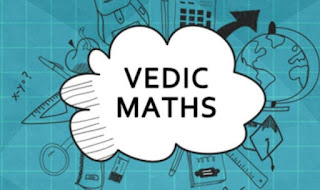VEDIC MATHS-65
VEDIC MATHS
By OMKAR TENDOLKAR
This is post number 65 from the series of "Vedic maths" blogs. Here in this blog we will learn about "The Osculation Method for checking divisibility of number by Negative Osculator"
Concept of Osculator :
The concept of ‘Osculator’ is useful to check the divisibility of a given number by divisors ending with 9 or 1 or a multiple there of.
An osculator is a number defined for any number ending in 9 or 1 and is obtained from the number by a simple mechanism described in this chapter.
The use of osculators would be severely limited if only these two categories of numbers viz. ending with 9 or 1 were considered. Interestingly, numbers ending with 3 and 7 can also converted to numbers ending with 1 or 9 by a suitable multiplication. The same techniques can be used for all such numbers too.
Osculators are categorized into two main types viz. positive and negative depending on whether the number ends with 9 or with 1.
- Dropping 1
- Remaining number is Negative Osculator
This method will help us find the divisibility rule for any number.
Examples :
1. Check whether 6603 divisible by 31 or not.
Again we find the Negative Osculator of 31.
- Dropping 1
- Remaining number is Negative Osculator i.e. 3
Negative Osculator of 31 is 3.
Now we osculate 6603 with 3.
To osculate a number, we multiply its last figure by the Negative Osculator and then subtract the result from its previous figure.
So, say we have 6603.
660 - (3 × 3)
= 651
Now we osculate again. We multiply 1 by 3 and subtract from 63.
= 65 - (1 × 3)
= 62
Now we osculate again. We multiply 2 by 3 and subtract from 6.
6 - (2 × 3)
= 6 - 6
= 0
For a number to be divisible, the result of the osculation should be the divisor, zero or a repetition of a previous result. This 0 indicates that the number 6603 is divisible by 31.
Answer :2. Check whether 11234 divisible by 41 or not.
Again we find the Negative Osculator of 41.
- Dropping 1.
- Remaining number is Negative Osculator i.e. 4
Negative Osculator of 41 is 4.
We now osculate 11234 with 5.
To osculate a number, we multiply its last figure by the Negative Osculator and then subtract the result from its previous figure.
So, say we have 11234.
1123 - (4 × 4)
= 1107
Now we osculate again. We multiply 7 by 4 and subtract from 110.
110 - (7 × 4)
= 82
Now we osculate again. We multiply 2 by 4 and subtract from 8.
8 - (2 × 4)
= 0
This 0 indicates that the number 11234 is divisible by 41 completely.
Answer :3. Check whether 2275 is divisible by 7 or not.
We first find the Negative Osculator of 7.
- Here, given number 7 end with 7, we can multiply it by 3, to convert it to a number which ends in 1 i.e. 21.
- Dropping 1
- Remaining digit is Negative Osculator i.e 2
Negative Osculator of 7 is 2.
We now osculate 2275 with 2
To osculate a number, we multiply its last figure by the Negative Osculator and then subtract the result from its previous figure.
Now we start osculating. So we have:
227 - (5 × 2)
= 217
Now we osculate again. We multiply 7 by 2 and subtract from 21.
21 - (7 × 2)
= 7
Since we got 7 (which is also the divisor) as the result of the osculation process, we can safely say that 2275 is divisible by 7.
4. Check whether 464411 by 71. or not.
We first find the Negative Osculator of 71
- Dropping 1
- Adding 1 to remaining digit i.e. 6 gives 7.
Negative Osculator of 71 is 7.
We now osculate 464411 with 7.
To osculate a number, we multiply its last figure by the Negative Osculator and then subtract the result from its previous figure.
Now we start osculating. So we have:
46441 - (1 × 7)
= 46434
Now we osculate again. We multiply 4 by 7 and subtract from 4643.
4643 - (4 × 7)
= 4615
Now we osculate again. We multiply 5 by 7 and subtract from 461.
461 - (5 × 7)
= 426
Now we osculate again. We multiply 6 by 7 and subtract from 42.
42 - (6 × 7)
= 0
This zero indicates that the number 464411 is divisible by 71 completely.
2. Check whether 52793 is divisible by 31 or not.
5. Check whether 210661 is divisible by 11 or not.
In next blog we will discuss about "2-digits Addition from left to right".
We will meet very soon through our next blog. Till that stay connected, stay healthy and stay safe.
Thanks
for giving your valuable time.


Comments
Post a Comment